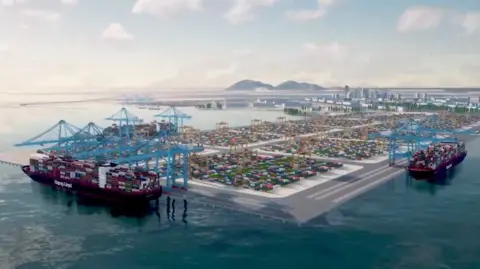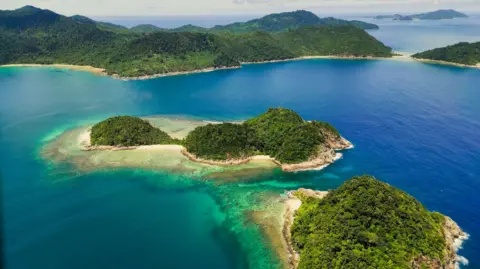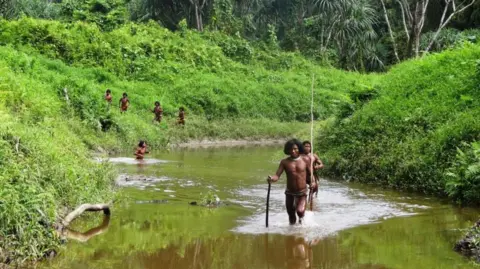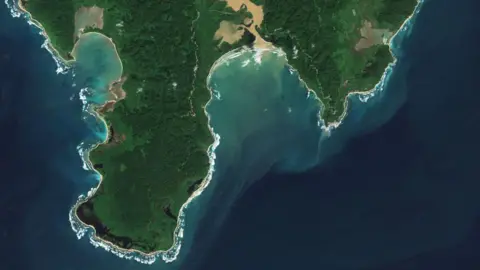An Indian port like Hong Kong could destroy an ancient nation

 India Shipping Ministry/X
India Shipping Ministry/X“The forest is our supermarket,” said Anice Justin. “We get almost everything from the forests on these islands. That’s what we live for.”
Mr Justin, a biologist, grew up in the Andaman and Nicobar Islands off the east coast of India. A government-controlled area, the ecologically fragile region consists of 836 islands, of which only 38 are inhabited. The Nicobar Islands are a separate group of islands in the southern part of the region, located about 150 kilometers (93 miles) south of Andaman Island.
Now Mr Justin is watching in horror as India plans a multibillion-dollar ‘Hong Kong-like’ development project on Great Nicobar Island, one of the largest and most secluded parts of the Nicobar archipelago.
Built on a budget of 720bn rupees ($9bn or £6bn) and spread over 166 sq km, the project includes a flexible port, a power plant, an airport and a new township, all designed to link the area to key world trade routes. along the Indian Ocean and the Suez Canal.
Located along the Strait of Malacca, one of the busiest shipping lanes in the world, the project promises to boost international trade and tourism – the government reckons up to 650,000 people will be living on the island by the time the project is completed in 30 years. .
Experts say the multibillion-dollar plan is part of India’s larger strategy to counter China’s growing influence in the region.
But the plan has caused fear among islanders who fear losing their land, culture and way of life, as the project threatens to push them to the brink of extinction.
 Getty Images
Getty ImagesThe Andaman and Nicobar Islands are home to some of the world’s most remote and vulnerable tribes, with five groups considered “critically endangered.”
These include the Jarawa, the Northern Sentinels, the Great Andamanese, the Onge, and the Shompen. While the Jarawas and Sentinels of the North remain untouched, the Shompen – about 400 people – of the Great Nicobar Islands are also at risk of losing their way of life to external pressures.
A nomadic tribe, most of them live deep in the forest where they hunt for a living – not much is known about their culture as very few have had contact with the outside world.
“The loss will be huge and it will hurt them very badly,” said Mr Justin, who has been documenting the island since 1985.
“Whatever we call development in foreign countries does not matter to them. They have a traditional life of their own.”
Environmentalists say there are huge environmental costs in this project.
Spread over 921 sq km (355.6 sq miles), about 80 percent of the Great Nicobar island is covered in rainforest, which is home to more than 1,800 animals and 800 plant species, many of which are endemic.
The Department of Environment said only 130 square kilometers or 14% of the island’s total area would be cleared for the project – but that’s still around 964,000 trees. Experts warn the real number could be much higher.
“The government always says that part of the forest will be washed away. But the infrastructure you build can lead to more pollution, which in turn will impact the entire region,” said Madhav Gadgil, an environmentalist.
The Department of the Environment did not respond to the BBC’s request for comment.
But Environment Minister Bhupendra Yadav in August said the project “will not disturb or displace” tribal people and had received environmental clearance based on “environmental assessment and after safeguards”.
However, not everyone is convinced.
Earlier this year, 39 international experts from different fields of social sciences had it he warned that the development project will be a “death sentence” for the Shompen as it will destroy their habitat.
A fear that worries Mr. Justin too: “The people of Shompen have no knowledge or ways to live in the industrial world,” he says.
 Archaeological Survey of India
Archaeological Survey of IndiaHe worries that the group could meet the same fate as the Nicobarese, the largest ethnic group on the island, who were displaced in 2004, when a huge tsunami in the Indian Ocean wiped out their villages.
Over the years, the government made efforts to resettle people in a different place – but it was also at a low cost.
“Many of the Nicobarese here are now manual laborers and live in settlements instead of their ancestral lands,” said Mr Justin. “They have no place to farm or keep animals.”
There is a fear that this program may again expose the Shompen to diseases.
“Uncontacted people have no immunity to foreign diseases such as influenza and measles which can also be eradicated – they usually lose about two-thirds of their population after contact,” said Callum Russell, chief executive of Survival International, a conservation group.
 Getty Images
Getty ImagesThere are also wider environmental concerns, particularly about the region’s marine life.
Ecologists are warning of the impact on Galathea Bay on the south-east side of the island, which has been a breeding ground for giant sea turtles for centuries.
Dr. Manish Chandi, a sociologist, says the program will also affect the saltwater crocodiles and the island’s water monitors, fish and wildlife.
The government’s statement said that the breeding grounds of these animals will not be changed.
But Mr. Chandi points out that there are other species of animals that live in abundance in this area. “The government is proposing to transport corals to places where they are not found naturally. What are they going to do with these other species?”
Even though the project will take 30 years to complete, people can’t help but feel worried about how it will irreparably change the balance of nature and the lives of the island’s indigenous people.
Follow BBC News India on Instagram, YouTube, Twitter again Facebook.





